O'odham
Winter Stories 2013
By Roy Cook, Opata Oodham edit
On cold winter nights, grandparents and other elders tell stories to pass
on the values of our people. Traditionally, O'odham parents have always
thought ahead to their children's futures, even when this meant speaking
English at home so that children could succeed in school. It is for each
of us to keep the stories alive Today, however, most of the old stories
are written and illustrated in books because the storytelling tradition
has weakened. Not many elders know the stories from their family or area.
But we can read and share related or remembered story traditions. It is
most important to replant the seeds of respect for the oral tradition
and appreciation of traditional culture.
In the Southwest there are some shared story telling traditions. For Hopi
poet Ramson Lomatewama, the winter solstice represents more than an astronomical
event. Its meaning extends beyond its ancient impact on the sowing of
crops and management of winter reserves. This is a sacred time, "filled
with mystery and power, because this is a time of reverence and respect
for the spirits," he told Arizona
Public Radio on January 10, 2002.
On the show, he discusses
how the new winter moon signals the Winter solstice and the beginning
of the storytelling season:
"The dogs work me up early. As I got out of bed to let them out,
I noticed that the moon was just a thin crescent. Experience told me that
the season known as kyaamuya would soon begin. Kyaamuya is filled with
mystery and power, because this is a time of reverence and respect for
the spirits. We're taught to be mindful of certain taboos. Even today
I tried to head those instructions. I don.t cut my hair or dig holes.
Even today, I try not to wander outside after dark, and I don't whistle,
make loud noises or beat on drums.
I remember going back to the reservation this time of year and spending
weekends at my grandmothers. A wood stove kept us warm. We had an old
lantern that hissed and had a soft light. None of us kids dared to go
outside when it got dark because it was kyaamuya and spirits were wandering
out there. But kyaamuya was also the time for storytelling. I remember
those nights when old men came to visit. Some of them I recognized as
family; others I didn't know. They'd eat supper with us, but well before
the table was cleared, someone would ask if they could stay and tell stories.
And we always passed around a yucca sifter basket filled with kutuki,
the Hopi version of popcorn. Some of the stories were long and could take
hours and some of the stories were short."
Traditional O'odham
stories vary from village to village according to Grace Palacios who grew
up in South Komelik, a village just north of the U.S./Mexico border.
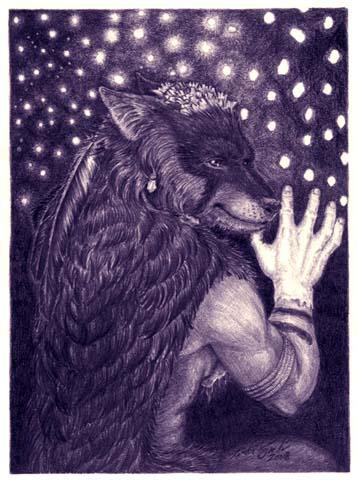 This
version of the Milky Way story she remembers features Coyote, a trickster
who doesn't listen well and always ends up in trouble.
This
version of the Milky Way story she remembers features Coyote, a trickster
who doesn't listen well and always ends up in trouble.
One day, Coyote was playing in someone's kitchen among the cooking
utensils. He was trying to find some food to eat, but then he heard someone
coming. He grabbed the first thing he saw, which was a bag of flour, and
ran. He thought the best way to escape was by going into the sky. As he
ran into the sky, the bag tore open. The flour flew everywhere, creating
the Milky Way galaxy.
"The Milky Way galaxy is a trace of what Coyote shouldn't have been
doing," Palacios said. "Not to mention, it gives me insight
of how my people made sense of their surroundings."
Long ago, the elders in each O'odham family told traditional stories to
their children and grandchildren. For the youngsters, it was considered
story time, said Lois Liston, a Tohono O'odham traditional arts teacher
at Ha:san Preparatory and Leadership School in Tucson. Ha:san is a bicultural
public high school designed for Native youths interested in attending
college.
The stories were told during winter because of the long nights and for
safety reasons. The O'odham believe they can talk about dangerous animals,
such as bears and snakes, when they're hibernating and can't harm anyone,
Liston said. Keep stories alive
 Today,
however, most of the old stories are written and illustrated in books
because the storytelling tradition has weakened. Not many elders know
the stories from their family or area, Liston said. One of her jobs as
a traditional arts teacher is to strengthen her students. cultural knowledge
by telling them the old stories. "I like telling traditional stories
to students because there are so many different versions," Liston
said. "When I share stories, I always tell them, 'This is how it
was told to me."
Today,
however, most of the old stories are written and illustrated in books
because the storytelling tradition has weakened. Not many elders know
the stories from their family or area, Liston said. One of her jobs as
a traditional arts teacher is to strengthen her students. cultural knowledge
by telling them the old stories. "I like telling traditional stories
to students because there are so many different versions," Liston
said. "When I share stories, I always tell them, 'This is how it
was told to me."
Another version of
the Milky Way story, for example, has Coyote spilling cornmeal to form
the stars. In another variation, Coyote steals a bag of white tepary beans
and scatters them while trying to escape, said Ron Geronimo, a Tohono
O'odham language teacher at Tohono O'odham Community College in Sells.
Yet another story describes an old man and a young boy. An old man was mean to his grandson, so the boy decided to leave and went up into the sky. The grandson lay in the sky and could see his grandfather down below. The grandfather could not find his grandson and began to feel badly about how he had treated him. The old man walked around crying as he looked for the boy. After time had passed, the grandson also began to feel badly and decided to come back down to give his grandfather a way to be with him. The boy told his grandfather that he had left because the old man was mean to him, and so he had made a new home in the sky. The boy gave his grandfather some seeds and told him to plant them. In four years, the old man would have enough seeds so he would never go hungry. The grandson also told his grandfather the seeds were white tepary beans. The gray streak above in the sky was made of these beans, and this was his home. He told his grandfather that whenever the old man missed him, he could look up and see him across the sky.
Each traditional
story carries a deeper meaning. "The importance of any story is what
it is trying to teach you," Geronimo said. "In this story it
is trying to teach us about how we should treat people and each other.
"Stories and baskets have traditionally played a large part in the
social and economic culture of the Tohono O'odham tribe. Aspects of traditional
stories often are woven into the designs of the Tohono O'odham baskets.
Mostly, baskets were very important in the everyday life of the tribe.
It was the women's achievement and artistic expression in the tribe to
weave the baskets. The baskets were used to haul grain and food. Many
baskets were woven so tightly that they could hold water and liquor. Baskets
were also very important in ceremonies, such as the Saguaro wine Rain
Ceremony.
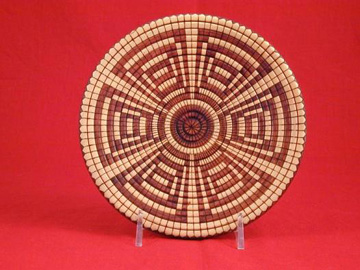 What
makes the Tohono O'odham basket so uniquely beautiful is their style of
weaving. The Tohono O'odham tribe has one of the most beautiful styles
of basket weaving. The tight coiled basket and amazing designs make their
baskets so appealing. Some of the baskets are woven so tight that they
are used to hold water and other liquids. A few tribe members believe
that the ancient baskets are of better quality than those that are made
today. Curators at the University of Arizona State Museum looking at ancient
baskets retrieved during archaeological digs admire the workmanship and
learn prehistoric designs and patterns. Many of the old baskets are made
with splits of willow branches that are typically hard to work with. Most
Tohono O'odham weavers today use primarily yucca, bear grass, and devils
claw. The designs in the baskets are not made with any dyes. All of the
baskets are made of natural colors. The white stitches in the baskets
are yucca and the coil is shredded bear grass. The black is from devils
claw, the rusty red is from the root of the yucca plant, and the green
is from yucca leaves.
What
makes the Tohono O'odham basket so uniquely beautiful is their style of
weaving. The Tohono O'odham tribe has one of the most beautiful styles
of basket weaving. The tight coiled basket and amazing designs make their
baskets so appealing. Some of the baskets are woven so tight that they
are used to hold water and other liquids. A few tribe members believe
that the ancient baskets are of better quality than those that are made
today. Curators at the University of Arizona State Museum looking at ancient
baskets retrieved during archaeological digs admire the workmanship and
learn prehistoric designs and patterns. Many of the old baskets are made
with splits of willow branches that are typically hard to work with. Most
Tohono O'odham weavers today use primarily yucca, bear grass, and devils
claw. The designs in the baskets are not made with any dyes. All of the
baskets are made of natural colors. The white stitches in the baskets
are yucca and the coil is shredded bear grass. The black is from devils
claw, the rusty red is from the root of the yucca plant, and the green
is from yucca leaves.
It has become harder for the Tohono O'odham tribe to gather the necessary
materials for basket weaving. Today tribal members have to travel many
miles to gather material for basket weaving, but it is important to the
identity of the tribe, so the tradition, although more difficult has been
maintained. In the ancient weaving of the Tohono O'odham the basic material
for basketry weaving could be collected with little effort, even though
many elements ripened or were unusable during different seasons. There
is little open land to the public and so much development of land that
it is getting more and more difficult to find the material needed to make
baskets. Some Materials, such as, devil's claw are now being cultivated
in a community garden in Sells, Arizona.
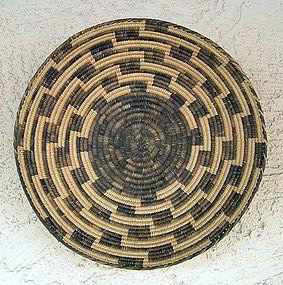 Basket
weaving for the Tohono O'odham has gone from an essential part of life
to a hobby. In ancient times, baskets were used every day for holding
food, gathering food, holding water and for ceremonial use. As time went
on and modern inventions came into tribal life, basket weaving became
a hobby for many people and a way to keep the tradition alive. Baskets
were sold for very little money and used by people for common things like
trashcans. Then people began to realize the art that went into basket
weaving.
Basket
weaving for the Tohono O'odham has gone from an essential part of life
to a hobby. In ancient times, baskets were used every day for holding
food, gathering food, holding water and for ceremonial use. As time went
on and modern inventions came into tribal life, basket weaving became
a hobby for many people and a way to keep the tradition alive. Baskets
were sold for very little money and used by people for common things like
trashcans. Then people began to realize the art that went into basket
weaving. 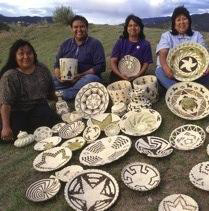 Simple
baskets took hours and hours of work, both for the weaving and the collection
of the weaving materials. People from all over the United States still
go to the Tohono O'odham reservation to buy baskets for very little money
and then sell them for hundreds and sometimes thousands of dollars, to
people all around the country.
Simple
baskets took hours and hours of work, both for the weaving and the collection
of the weaving materials. People from all over the United States still
go to the Tohono O'odham reservation to buy baskets for very little money
and then sell them for hundreds and sometimes thousands of dollars, to
people all around the country.
When the O'odham tribe realized how much their baskets were selling for
they decided to market the baskets themselves, cutting out the middleman.
As a result, sales are the main reason for weaving nowadays, though some
baskets still have traditional uses.
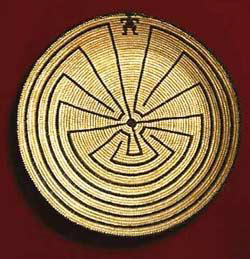 There
is no one meaning to the Man in the Maze. Interpretations of the image
vary from family to family. A common interpretation is as follows: The
human figure stands for the O'odham people. The maze represents the difficult
journey toward finding deeper meaning in life. The twists and turns refer
to struggles and lessons learned along the way. At the center of the maze
is a circle, which stands for death, and for becoming one with Elder Brother
I'itoi, the Creator. Other O'odham see the image of a man as representative
of an individual, or all of mankind, or I'itoi himself.
There
is no one meaning to the Man in the Maze. Interpretations of the image
vary from family to family. A common interpretation is as follows: The
human figure stands for the O'odham people. The maze represents the difficult
journey toward finding deeper meaning in life. The twists and turns refer
to struggles and lessons learned along the way. At the center of the maze
is a circle, which stands for death, and for becoming one with Elder Brother
I'itoi, the Creator. Other O'odham see the image of a man as representative
of an individual, or all of mankind, or I'itoi himself. 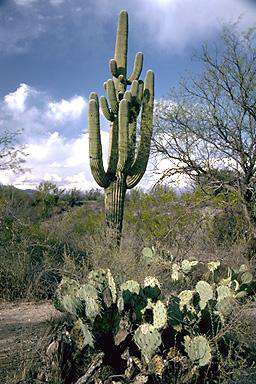
Storytelling helps connect the O'odham people to their landscape. There
are stories about the sky, the weather, the mountains, saguaros and desert
animals. It is this landscape that makes them Desert People, Palacios
said. Stories remind her of her ancestors and make the connection with
the past more tangible. O'odham stories show that everything has a purpose.
They also help establish values and boundaries that teach O'odham people
how to live their life." Liston said, "The importance of the
stories is to give directions and guidance to the younger generation on
how to live as a Tohono O'odham, The stories also remind us of our heritage
and culture and the responsibilities we have to one another."
Today, we as a Nation need to return to a view that puts learning at the
center of childhood. Studying at school, learning through play and family
life-this is the work of childhood. In the same way that learning is central
to childhood; traditional education is a key to our Tribal Nation's success.
Nationwide, studies have proven that western higher education brings higher
income, lower unemployment, and better health for individuals, and higher
tax revenues, lower crime rates, and improved civic life for the total
American community.
Hoping for a Happy, Healthy, and Holiday for all our Families. Ho'ige
idalig.